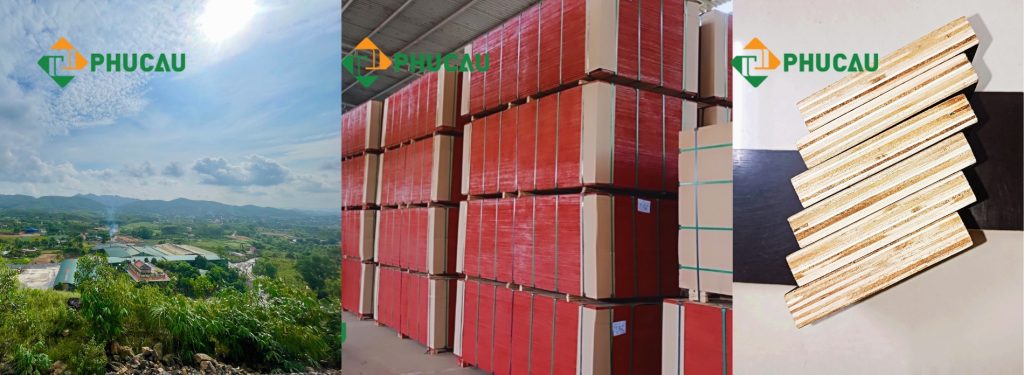1. FILMFACED PLYWOOD- CONCEPT
Filmfaced Plywood also known as shuttering plywood or Tego plywood, is a type of plywood that is specially designed for use in construction and concrete formwork. It is characterized by its durable and smooth surface, which is typically covered with a layer of phenolic film that provides resistance to water,chemicals, and abrasion. The film face gives the plywood added strength and protects it from the elements during construction projects.Filmfaced Plywood is commonly used in concrete formwork applications, where it serves as a temporary mold for pouring and shaping concrete structures such as walls, columns, and beams. The smooth and treated surface of film-faced plywood prevents the concrete from sticking to the plywood, allowing for easy removal after the concrete has cured.
Filmfaced Plywood comes in various thicknesses and sizes, and it’s an essential material in construction projects due to its durability, ease of use, and resistance to water and tear.

2. FILMFACED PLYWOOD: TECHNICAL SPECIFICATIONS
2.1 Filmfaced Plywood Dimensions: Filmfaced Plywood is available in the following dimensions: Typically, Filmfaced Plywood comes in the following main sizes (width x length):
- 900×1800 (mm): Suitable for customers in the Japanese market.
- 1220×2440 (mm): This is the standard common size, suitable for most markets.
- 1250×2500 (mm): Suitable for customers in the Turkish market.
- Other dimensions are available upon customer request (less common).
2.2 Filmfaced Plywood Thickness : The thickness ranges from 9.0mm to 21.0mm or as per customer requirements. The common thicknesses in the Filmfaced Plywood market are 12.0mm, 15.0mm, and 18.0mm.
2.3 Filmfaced Plywood core: The core of Filmfaced Plywood is usually made from several layers of thin veneer stacked together. Commonly used wood types include poplar and birch, or other types of plantation-grown wood.
2.4 Filmfaced Plywood glue: Adhesion strength is evaluated through the criterion of continuous boiling of a sample piece without delamination. Most Filmfaced Plywood in the market has a boiling time of 3 to 12 hours. A higher content of Melamine or phenolic in the adhesive leads to increased resistance to boiling water, with a maximum of 72 hours. Boiling time significantly affects the product’s reusability.
2.5 Filmfaced Plywood Load-Bearing and Bending Strength: These factors depend mainly on the quality of the adhesive and the thickness of the plywood sheet. Thicker sheets and higher-quality adhesives result in higher load-bearing and bending strength. Quality standards for Filmfaced Plywood include ISO 9000-2015, TCVN 7755:2007, TCVN 11205:2015…
3. FILMFACED PLYWOOD: TYPES
There are some types of Filmfaced Plywood in the markets:
3.1 Film-faced plywood is classified according to the number of film faces:
1. Single Sided Filmfaced Plywood ( Single Faced Tego Plywood):
Single Sided Tego Plywood – Single sided filmfaced plywood – www.phucau.com
Single Sided Filmfaced Plywood (Single Sided Tego Plywood) Has just appeared on the markets ( Malaysia, Singapore, Brunei, Vietnam,…) in recent years, This product has the same structure & properties as the double-sided filmfaced plywood on the market, except in the final finishing stage, instead of gluing film on both sides of the board, this type only needs film one side of the board. This greatly reduces the cost of the product, but the efficiency is almost equivalent to the double-sided filmfaced plywood.
2. Double Sided Filmfaced Plywood (Double Faced Tego Plywood):

Double Sided Filmfaced Plywood – Double Tego Plywood – Shuttering Plywood: is popular on the market and is favored by customers because it is consistent with past consumption practices. The product is covered with film on both sides of the board, helping the board to be uniform on both sides. When using, customers do not need to care which side is left or right like one-sided filmfaced boards. Because it is covered with film on both sides, the price of this product is also higher than single sided filmfaced plywood.
3.2 Filmfaced plywood, according to film surface characteristics, has the following types:
• No-Logo Filmfaced Plywood:

The film surface has a uniform color (black, dark brown, sepia, red, blue…). This type is very easy to detect errors during the production process such as film burn, film peeling, film blistering… This type of Filmfaced Plywood is very difficult to distinguish which factory produced it, so it is favored by many factories or commercial customers. preferred to avoid affecting the brand & reputation when product quality complaints occur.
• Logo Filmfaced Plywood:

The film surface is printed with logos according to customer requirements, creating a private label for each product. Logo Filmfaced Plywood is more aesthetically pleasing, easy to hide small defects on the surface, customers can easily distinguish and recognize which factory or commercial product the product is supplied by, and quality complaints cannot be made. will be more accurate. However, product quality depends entirely on the reputation and quality commitment of the manufacturer, not on whether a logo film is applied or a plain film is applied.
3.3 Classification of film-coated plywood according to thickness and size:
The film surface is printed with logos according to customer requirements, creating a private label for each product. Logo Filmfaced Plywood is more aesthetically pleasing, easy to hide small defects on the surface, customers can easily distinguish and recognize which factory or commercial product the product is supplied by, and quality complaints cannot be made. will be more accurate. However, product quality depends entirely on the reputation and quality commitment of the manufacturer, not on whether a logo film is applied or a plain film is applied.
3.3 Classification of Filmfaced Plywood according to thickness and size:
Filmfaced Plywood is divided into many types depending on thickness or customer requirements. The thickness of the board can vary from 9.0mm to 21.0mm or some other special thickness upon request.
The main types of thickness popular on the market are:
– 11mm Filmfaced Plywood
– 11.5mm Filmfaced Plywood
– 12mm Filmfaced Plywood
– 14mm Filmfaced Plywood
– 15mm Filmfaced Plywood
– 17mm Filmfaced Plywood
– 18mm FFilmfaced Plywood
With each different thickness, the usability of Filmfaced Plywood products is also different. For example, a thickness of 11-12mm is often used for places where large areas of concrete need to be poured such as floors/ceilings; The thickness of 17-18mm is often used for locations that need to bear great force such as beams, building foundations…
3.4 Filmfaced plywood classified by quality:
Filmfaced Plywood currently, most manufacturers are classifying the quality of boards according to 3 main groups: Type A1 (Exporting standard), Type A2 (Exporting + Domestic), Type A3 (Domestic).As a manufacturer of Filmfaced plywood for many years, we’re PHU CAU MANUFACTURE have been focusing core & glue of Filmfaced plywood as it’s very important role, it affects the structural sustainability, bearing properties, water resistance ability & number of reuses, Please contact PHU CAU company for advice & get the most suitable product for each contruction project.
4. FILMFACED PLYWOOD: USAGE APPLYCATION
Filmfaced plywood is widely used in various construction & formwork applications due to its durability, moisture resistance, & smooth surface finish. Some common usage applications of Filmfaced plywood include:
Concrete Formwork: Filmfaced plywood is extensively used as formwork for casting concrete structures such as walls, columns, beams, & slabs. The smooth film surface prevents concrete from sticking to the plywood, ensuring easy removal & leaving a clean finish.
Building Foundations: It’s used in building foundation formwork to create sturdy & stable molds for pouring concrete footings & foundations.
Wall & Column Construction: Filmfaced plywood is employed in the construction of walls & columns to create precise & well-defined structures.
Bridge Construction: Plywood panels are used in the construction of bridges for creating formwork that can h&le the weight & pressure of wet concrete.
Slab Construction: Plywood sheets are used to create formwork for concrete slabs, providing a level surface for pouring & curing concrete.
Tunnel Construction: In tunnel construction, plywood formwork is used to shape concrete structures that line the interior of tunnels.
Staircase Construction: Plywood is used to build formwork for staircases, ensuring accurate dimensions & a smooth surface.
Architectural Elements: It’s used for creating intricate architectural elements such as decorative panels, facades, & textured surfaces.
Structural Members: Filmfaced plywood is used for creating structural components like beams & columns with precise dimensions & smooth finishes.
Exterior Walls: Some construction projects use Filmfaced plywood as the external sheathing of walls before applying final cladding materials.
High-Rise Construction: In high-rise buildings, plywood formwork is used for constructing tall columns, slabs, & walls efficiently.
Infrastructure Projects: Filmfaced plywood is used in various infrastructure projects like dams, reservoirs, & retaining walls to shape large concrete structures.
Precast Concrete: It’s used in precast concrete manufacturing to create molds for producing precast components with consistent quality.
Temporary Structures: Filmfaced plywood can be used in temporary structures such as stages, platforms, & event setups.
Custom Woodwork: Some woodworking projects, like creating furniture or custom woodwork, can also benefit from the smooth finish & durability of Filmfaced plywood.
Filmfaced plywood’s versatility, strength, & resistance to moisture make it an essential material in construction projects where precise & durable formwork is required.
5. FILMFACED PLYWOOD: ADVANTAGES – DISADVANTAGES
5.1. Filmfaced Plywood: Advantages
– Filmfaced Plywood is cheaper compared to other types of formwork such as iron, aluminum, plastic formwork…
– Filmfaced Plywood has very economical construction costs because it can be reused many times and has high economic efficiency.
– Filmfaced Plywood saves a lot of labor, is quick to construct, and easy to dismantle and install.
– Filmfaced Plywood will make the concrete surface very smooth when used, no need to re-plaster.
– Filmfaced plywood has good water and humidity resistance & is easy to clean after use.
– Filmfaced plywood has high compressive strength, bending force, and elasticity, meeting technical standards for construction safety.
– Filmfaced Plywood is easy to process and cut into different sizes to suit the shape of the project.
– Contribute to protecting natural forests, encouraging afforestation, and developing industries from planted wood.
– Filmfaced Plywood can be easily sold and liquidated after construction is completed to recover part of the capital.
5.2. Filmfaced Plywood : Disadvantages
– Strength is lower than iron formwork,
– The number of reusable is less than iron, aluminum formwork.
– The surface is slippery so workers need to be careful when moving on the Filmfaced Plywood surface.
– The edges of conventional Filmfaced Plywood are very sharp, so be careful when carrying them and use protective gloves to ensure safety.
6. FILMFACED PLYWOOD: PRODUCTTION PROCESSING
Filmfaced plywood has a production process from the beginning of input materials to the final product. Depending on the level of investment, some factories meet standards such as PHU CAU below:

7. FILMFACED PLYWOOD: THE DETERMINANT FACTORS OF QUALITY
7.1 Filmfaced Plywood The first factor that determines quality is glue (adhesive)
This is the most important factor that determines the durability of the Filmfaced Plywood panel. The glue will determine the number of times the Filmfaced Plywood panel can be reused and a number of other characteristics such as water resistance, mold resistance, and anti-mold resistance. moisture, termite resistance,…
Good glue must meet the following standards:
– Do not use glue that is past its expiration date or has abnormal signs to ensure optimal adhesion.
– Melamine or phenolic content in glue must meet the manufacturer’s commitment.
For example, 10% Melamine glue is understood to mean that in 100 kg of glue there is 10 kg of Melamine. Melamine content fraud often occurs to reduce costs and increase profits. To avoid this risk when purchasing, you should not ask the manufacturer for a commitment on Melamine or phenolic content, instead, you should ask the manufacturer for a commitment on how long the sample can be continuously boiled. now no peeling. Products sold on the market can be reused 6-8 times, usually using Melamine glue to ensure a boiling time of 8-10 consecutive hours or more.
– Glue coating rate and glue uniformity on the surface of the board. This is very important, even more important than the Melamine or Fenolic content in the glue. If the worker applies glue carelessly, the glue application ratio is not correct, or the glue density is not spread evenly on the surface of the board, it will lead to the overall adhesion of the board being uneven between locations or blistering. At some point, when cutting the Filmfaced Plywood the number of reuses of the cut pieces will not be the same due to different qualities.
To limit this risk, you should visit the factory directly and see the manufacturer’s quality control process. In addition, you should further evaluate the manufacturer’s reputation through partners who have used their products to make an accurate decision.
7.2 Filmfaced Plywood The second factor that determines the quality: Wood core (board core)
The wooden core is the skeleton of the Filmfaced Plywood panel, it determines the strength, bending, elasticity… of the panel. The number of times a Filmfaced Plywood panel can be reused depends on whether the wood core and the glue are good or not.
A good wooden core must meet the following standards:
– Less edge gaps and when cut into small pieces.
– Have as many thin layers of wood stacked together as possible. For example, a Filmfaced Plywood with a thickness of 11-12mm usually has 5-8 layers. Of the same thickness, a Filmfaced Plywood made from 5 layers of wood will not be as durable as a Filmfaced Plywood made from 8 layers of wood core veneers

– The moisture content of wood core when being produced and allowed to cool completely must be below 12%. Wood core moisture over 12%, if left for a long time, it will easily lead to moldy wood core, reducing the adhesion and bearing capacity of the product.
– No swelling or layer separation.
– Using plantation hard woods such as eucalyptus, acacia, rubber, … will have better durability than using soft woods such as pine, lard, bodhi, …
7.3 The third factor that determines the quality of Filmfaced Plywood Film surface
Currently, all Filmfaced Plywood on the market use a film made from paper coated with a layer of phenolic glue on the surface. The film surface after pressing is considered to ensure quality: it is smooth, flat, with few burns or peeling film.
The quality of coated film sheets depends on the following factors:
– Is the expiration date still available?
– Is the Phenolic adhesive coating rate uniform on the paper surface? The greater the amount of phenolic glue on the surface of the paper, the better the film.
– What is the quality of the paper used for gluing?
– How to preserve the film when in storage? To preserve the film, it is best to put it in a cold room with low humidity.
7.4 Filmfaced Plywood: The fourth factor that determines the quality is the pressing technique
Filmfaced Plywoodtechnique is also a very important factor affecting the quality of Filmfaced Plywood. When the correct pressing technique is followed, Filmfaced Plywood will be produced with the best quality. Cheating the pressing time to increase productivity, cheating the pressure to reduce wood loss or cheating the temperature to limit explosion, etc. all lead to the deterioration of the quality of the Filmfaced Plywood.
Some optimal parameters in pressing technique to ensure the quality of Filmfaced Plywood are as follows:
Temperature:
– Hot pressing: from 120 to 130 degrees Celsius
– Film pressing: from 145 to 155 degrees Celsius
The optimal pressure is as follows:
– Hot pressing board thickness 11-12mm: minimum 125 tons/m2 or more
– Hot pressing board thickness 14-15mm: minimum 140 tons/m2 or more
– Hot pressing board thickness 17-18mm: minimum 155 tons/m2 or more
– Optimum film pressing force of thicknesses: from 170-190 tons/m2
Pressing time:
– Hot pressing board thickness 11-12mm: at least 15 minutes under pressure, incubate from 05-30 minutes depending on the moisture content of the board.
– Hot pressing board thickness 14-15mm: at least 20 minutes with pressure, incubate from 05-30 minutes depending on the moisture content of the board.
– Hot pressing board thickness 17-18mm: at least 25 minutes with pressure, incubate from 05-30 minutes depending on the moisture content of the board.
– Laminating film thicknesses: from 2-5 minutes with pressure, incubate the board from 01-10 minutes depending on the moisture content of the board and pressing temperature.
7.5 Filmfaced Plywood: The fifth factor determining quality is construction techniques and storage at the construction site
Construction techniques for Filmfaced Plywood:
For each construction purpose, it is necessary to use the right type of Filmfaced Plywood in terms of thickness, size, scaffolding, etc. to increase the number of rotations.
Scaffolding system must be firm, bars and racks must meet standards to spread the load evenly between positions on the film-covered plank when pouring concrete.
For example, 11-12mm thin Filmfaced Plywood should not be used to make formwork for beams, columns, and pillars because these are locations that have to bear great forces, limit bending, etc. Misuse will lead to slabs. Filmfaced Plywood is damaged quickly, does not guarantee the number of reuse times, causing waste.
Filmfaced Plywood: How to preserve Filmfaced Plywood, users should pay attention to the following issues:
• Must have pallets or pallets, avoid placing them directly on the ground or on damp or watery floors.
• Clean board edges and surfaces after each use.
• Cover with tarpaulin if you have to leave it outdoors for a long time.
• If the board is wet, let it dry before placing it in storage.
• Storage needs to be neat. When erecting, pay attention to the balance point to avoid bending or twisting the board.
8. FILMFACED PLYWOOD: CHECKING QUALITY
– Check the surface of the film: it must be flat, smooth, with littel small burns, film peeling, no blistering, …
– Waving Test the plywod: no broken or delamitated layers
– Check the edge of the board: less gaps, even and good painting color, …

– Check the inside of the board: cut into small pieces without peeling off layers, less gaps, …
– Check the adhesion quality: cut the sample pieces and boil them continuously in boiling water, check every 1 hour to see when the sample pieces peel off. Normally, good Filmfaced plywood on the market will withstand continuous boiling water for at least 8-10 hours or more.
– Check the thickness of the board: you can use calipers to measure 4 sides of the board, if at least 1 side meets the requimments, it’s okay. Usually the manufacturer will commit to a tolerance of +/- 0.3-0.5 mm. For example, if the required thickness is 12.0mm, the allowable tolerance will be from 11.5-12.5mm for goods meeting quality standards type 1. For goods meeting quality standards type 2 and 3, there may be a number of tolerance panels of + /- 1 mm.
Additionally, you can quickly check by measuring the total height of the whole bale and dividing it by the number of panels on the bale to get the average thickness of the whole bale. If the average thickness is within the allowable tolerance range, the requimments are met. Usually, customers want the average bale thickness to always be positive compared to the requimment.
The above test method applies to Filmfaced plywood products of grade A1 quality. If you buy A2 or A3 quality goods, the above defects will be more per board.
However, if you are the end user, the 3 most important factors that determine the number of times you can reuse Filmfaced boards are: first, check the adhesive quality when continuously heated in boiling water; second, check that the average thickness of the board must be within the allowable tolerances; Third, if you buy goods with quality class 1 or 2, you need to check the probability of whether they are mixed with quality goods of class 3 or not (Some signs to identify quality goods of class 3: the wood core is bulging with a wide width. from 3-5cm or more, the number of blisters on the Filmfaced plywood is 2 or more, the area of the film peeling is 10cm or more). The other factors are only used to enhance the durability and increase the aesthetics of the plank.
Currently, Phu Cau Company – Plywood factory in Bac Giang, Committed to high quality Filmfaced plywood and global export,
Phu Cau Company is proud to be one of the leading plywood manufacturers in the Bac Giang area and the whole country. We focus on producing Filmfaced plywood with the best quality, meeting the requimments strict market demands.
We have been manufacturing top quality Filmfaced plywood , including top 1-side Filmfaced plywood and double-side Filmfaced plywood . Our products have been highly appreciated by customers around the world, including markets such as Korea, Malaysia, Thailand, Philippines, Singapore, Brunei, Oman and many other countries.
We are confident in providing the highest quality products along with dedicated and efficient service. Our team is always ready to fulfill orders quickly and accurately, while maintaining consensus in improving product quality and performance. Connection and cooperation are important factors for us to develop together. We hope to be able to establish cooperative relationships with customers, together creating the best solutions for the Filmfaced plywood market. Besided of Filmfaced Plywood we also have Calibrated Commercial Plywood, Matply, Barecore plywood, Core Veneers, Wooden Traditional House,… Kindly contact us today to start an exciting journey of cooperation and bring sustainable value to both parties.
—THANK YOU—














